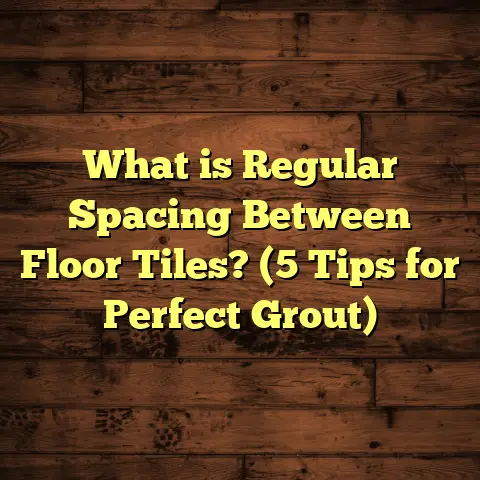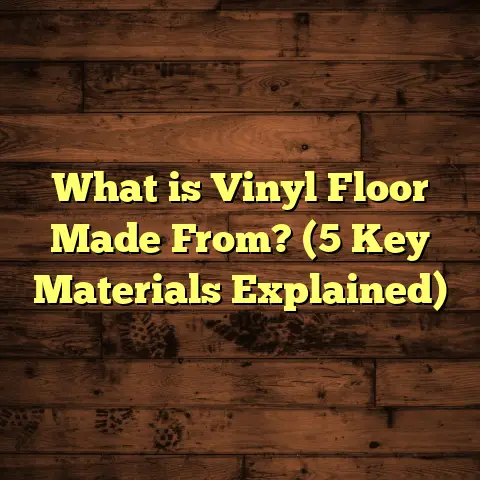What is Under Parquet Flooring? (5 Key Insights for Homeowners)
I once had a homeowner call me in a panic because their beautiful new parquet floor was sounding hollow and creaky just months after installation. After some investigation, it turned out the problem wasn’t the parquet itself but what was underneath it. That’s when I realized how often folks overlook the subfloor or underlayment beneath parquet flooring — and how crucial it really is.
If you’re thinking about installing parquet floors or already have them, understanding what lies beneath can save you headaches, money, and a lot of frustration. So let me share some key insights from my years working with parquet floors, including details that most people don’t talk about.
What Is Under Parquet Flooring?
At its core, the phrase “under parquet flooring” refers to the layers beneath the visible parquet surface. Parquet flooring itself is a type of wood flooring made by arranging small pieces of wood in decorative geometric patterns. But what supports that surface and makes it perform well over time? That’s where the subfloor and underlayment come into play.
The subfloor is the structural layer, usually made of plywood, oriented strand board (OSB), or concrete, depending on your home’s construction. It provides the solid base that holds the flooring in place.
Above or sometimes directly on the subfloor sits the underlayment, which is a thinner layer that serves several purposes: it smooths out imperfections, adds moisture protection, and sometimes provides sound insulation or cushioning.
The combination of these layers beneath the parquet is critical for durability, comfort, and appearance.
Why Should You Care About It?
Many homeowners assume once the parquet is installed, their work is done. But without proper preparation and care of what’s underneath, the floor can suffer from issues like:
- Buckling or warping due to moisture
- Squeaking caused by movement between layers
- Uneven surfaces leading to premature wear
- Poor insulation affecting comfort and noise
From my experience, these problems often arise because of neglect or misunderstanding of the under layers. So let’s break down some important factors to help you avoid these pitfalls.
1. Subfloor Material Matters More Than You Think
When I first started in this business, I didn’t give much thought to subfloors — I assumed they were all pretty much the same. That was a mistake.
Subfloors come in different materials:
- Plywood: Most common in wood-frame houses; strong and stable.
- Oriented Strand Board (OSB): A cost-effective alternative to plywood but more susceptible to moisture damage.
- Concrete: Found in slab-on-grade foundations or basements.
Each type requires specific preparation for parquet installation. For example, concrete subfloors need to be sealed and leveled carefully to prevent moisture from damaging the parquet.
Here’s a quick data point for you: According to a 2023 study by the National Wood Flooring Association (NWFA), about 45% of parquet installation failures were traced back to improper subfloor preparation — a huge chunk!
The Importance of Flatness and Cleanliness
No matter what material your subfloor is made of, one thing matters above all: flatness. Parquet floors are made of many small pieces laid closely together. If the subfloor isn’t flat and smooth, you’ll see gaps and movement later on.
I always measure flatness using a long straightedge or laser level before installation. The accepted tolerance for flatness is usually about 3/16 inch deviation over a 10-foot span. If your floor doesn’t meet this standard, you’ll need leveling compound or sanding.
Cleanliness is just as important. Dust, dirt, or debris can interfere with adhesive or cause unevenness in floating floors. This might sound simple but many installations fail because contractors skip thorough cleaning before laying down parquet.
My Experience with Different Subfloor Types
Let me share some stories:
- Plywood Subfloor: In a mid-century home renovation I worked on, the plywood subfloor was in surprisingly good shape. We just cleaned it well and installed parquet directly with glue-down method. The floor has held up beautifully for over 7 years now.
- OSB Subfloor: I had a client who wanted to save money by using OSB beneath their parquet in a new build. After moisture testing showed high levels, we added a layer of plywood on top to create a stable base and vapor barrier underneath. This extra step prevented warping completely.
- Concrete Subfloor: One basement project involved installing parquet over concrete slab. We ground down uneven spots and applied a moisture barrier before using an underlayment designed for concrete floors. That job ended up being one of my favorites because the floor stayed flawless despite potential moisture risks.
How to Check Your Subfloor
If you’re curious about your own home’s subfloor condition:
- Remove a small piece of existing flooring if possible
- Look for signs of water damage (discoloration, mold)
- Check for softness or sponginess by pressing firmly
- Use a moisture meter if available
- Look for cracks or unevenness
If any of these issues pop up, it’s better to address them before installing or repairing parquet.
2. The Role of Underlayment: More Than Just a Cushion
Underlayment options can vary widely: foam, cork, felt, rubber — each with pros and cons.
The right underlayment:
- Absorbs sound (important if you have neighbors below)
- Provides thermal insulation
- Offers moisture resistance
- Helps smooth minor floor imperfections
I always recommend using an underlayment compatible with parquet wood types and your subfloor material. For instance, cork underlayment works wonders in older homes for soundproofing but may not be ideal over concrete slabs without a moisture barrier.
Why Underlayment Is Often Overlooked
I’ve seen many homeowners skip underlayment to save money or because they think “wood flooring is solid enough already.” But this can cause issues down the line.
Without proper underlayment:
- Your floor might feel harder underfoot.
- You may hear more footstep noise.
- Moisture can more easily reach your parquet.
- Minor subfloor imperfections can telegraph through to the surface.
On one project in an apartment complex where noise complaints from downstairs neighbors were frequent, installing cork underlayment beneath parquet made a huge difference in sound transmission — almost eliminating complaints altogether.
Types of Common Underlayments
Foam Underlayment
Lightweight and cost-effective, foam underlayments offer decent cushioning and some sound absorption but are less effective against moisture.
Cork Underlayment
Natural material with excellent soundproofing and thermal properties. Also mold resistant but slightly more expensive.
Rubber Underlayment
Highly durable and great for sound insulation but usually pricier. Often found in commercial or high-end residential projects.
Felt Underlayment
Traditional choice for hardwood floors; provides good cushioning but less moisture protection unless combined with vapor barriers.
Choosing the Right Underlayment for Parquet Floors
Here’s what I usually consider:
- What type of subfloor you have (concrete needs moisture barrier)
- Your budget
- Noise concerns (busy homes or apartments benefit from cork/rubber)
- Desired comfort level
- Local climate (humid areas need better moisture protection)
3. Moisture Control Under Parquet Floors
Moisture is often the enemy of wood flooring. Underneath your parquet, if moisture isn’t properly managed, you might see cupping, swelling, or mold growth.
Moisture can come from:
- Ground moisture through concrete slabs
- Humidity trapped between layers
- Leaks from plumbing or HVAC systems
Testing for moisture in your subfloor before installation is crucial. I use professional moisture meters for this step every time.
Why Moisture Is So Damaging
Wood is hygroscopic — it absorbs and releases moisture based on its environment. Too much moisture causes wood fibers to swell unevenly. This leads to:
- Cupping: edges rise higher than center
- Crowning: center rises higher than edges
- Buckling: boards lifting off subfloor
- Mold/mildew growth beneath flooring
If unchecked early on, these problems often require costly repairs or full replacement.
How To Test Moisture Levels
There are two common methods I use:
- Calcium Chloride Test: Measures moisture vapor emission rate from concrete slabs.
- Pin Moisture Meter: Measures moisture content directly in wood or subfloor materials.
The NWFA recommends moisture content shouldn’t exceed 12% before installing wood floors on plywood/OSB. For concrete slabs, vapor emission should be below 3 pounds per 1,000 sq ft per 24 hours.
Solutions To Manage Moisture
If tests show high levels:
- Install vapor barriers beneath or on top of concrete slabs.
- Use moisture-resistant underlayments.
- Improve crawl space ventilation.
- Fix any plumbing leaks promptly.
- Consider engineered parquet products designed for higher moisture tolerance.
My Story About Moisture Issues
Once I worked on an old Victorian house where previous owners had ignored crawl space ventilation for decades. When we removed the old carpet covering their parquet floor, there was noticeable mold beneath due to trapped humidity.
We cleaned everything out, installed a heavy-duty vapor barrier beneath the floor joists, added vents to improve airflow, then reinstalled new parquet with appropriate underlayment.
The result? Healthy floors that stayed perfectly flat and dry for years afterward.
4. Installation Techniques Affect What’s Underneath
How parquet flooring is installed also impacts what lies beneath it and how well it performs long term.
There are mainly three methods:
- Glue-down: Parquet panels are glued directly to the subfloor.
- Floating: The floor “floats” over an underlayment without being attached to the subfloor.
- Nail-down: Less common for parquet but involves nailing wood strips to the subfloor.
Each method requires specific prep for the subfloor and underlayment.
Glue-down Installation
This method creates a solid connection between subfloor and parquet surface. It’s popular because it reduces movement and provides excellent stability.
However:
- The subfloor must be very clean and flat.
- Moisture levels must be low.
- Proper adhesive must be chosen based on subfloor type.
Floating Installation
Floating floors rest on an underlayment without glue or nails attaching them to the subfloor. This method allows slight movement and expansion without damage but relies heavily on good quality underlayment to prevent noise or unevenness.
Floating is sometimes used in DIY projects since it’s easier to install but may not be best for all parquet styles.
Nail-down Installation
Nail-down is rarer with parquet but still common with other hardwood floors. It requires wood subfloors thick enough to hold nails securely.
My Experience With Installation Methods
On one project in a commercial office building where noise control was vital, we chose glue-down installation combined with cork underlayment over concrete slab — this gave us excellent sound dampening without sacrificing durability.
For a homeowner wanting quick installation with less prep work on plywood subfloor, floating installation worked well — but I warned about potential noise issues that might arise later if not paired with quality underlayment.
5. How I Estimate Costs and Plan Using FloorTally
Estimating costs for flooring projects can get complicated fast — materials vary, labor can differ by region, and unexpected expenses pop up.
I’ve been using FloorTally for several years now to keep my estimates realistic and organized. What I like about it is how it combines local material prices with labor rates and even factors in waste percentages for cuts and mistakes.
When planning parquet projects, I enter:
- Room dimensions
- Type of parquet material
- Subfloor condition (and any prep needed)
- Underlayment choices
FloorTally then gives me a detailed estimate showing material costs, labor, waste allowance, and total price. This helps me set clear expectations with clients upfront.
One time, this tool helped me spot that adding a moisture barrier and plywood overlay on an uneven slab would increase costs by about 15%. Knowing this early allowed us to budget properly instead of facing surprise bills later.
Why Budgeting Matters So Much With Parquet Floors
Parquet flooring often requires more prep work than other flooring types due to its precision installation needs—this means hidden costs can surprise you if not planned well.
For example:
- Subfloor repairs
- Moisture mitigation steps
- High-quality adhesives or fasteners
- Specialized underlayments
Using tools like FloorTally makes sure these factors aren’t overlooked when quoting prices.
Bonus Insight: Maintenance Starts From Below
You might think maintenance only applies after your floor is installed—but what’s underneath plays a big role in how easy your floor is to care for later on.
If your subfloor allows moisture buildup or moves too much due to poor support, you’ll likely face cracking joints or loose tiles quicker than expected.
I always remind clients that regular checks beneath floor vents or accessing crawl spaces (if possible) help catch issues early before they affect the visible floor above.
Final Thoughts (Without Saying So)
What’s beneath your parquet floor has more impact than most people realize—from structural support to moisture control and comfort underfoot.
The subfloor type and condition establish the foundation; underlayment adds protection and comfort; moisture control prevents costly damage; installation methods tie it all together; budgeting tools help plan realistically throughout the process.
I hope my stories and insights help you feel better prepared whether you’re installing new parquet floors or maintaining existing ones. If you ever want advice tailored specifically for your home situation—or just want to chat about flooring options—I’m here anytime!
Have you looked at what’s under your floors lately? It might just change everything about how you care for them going forward!





